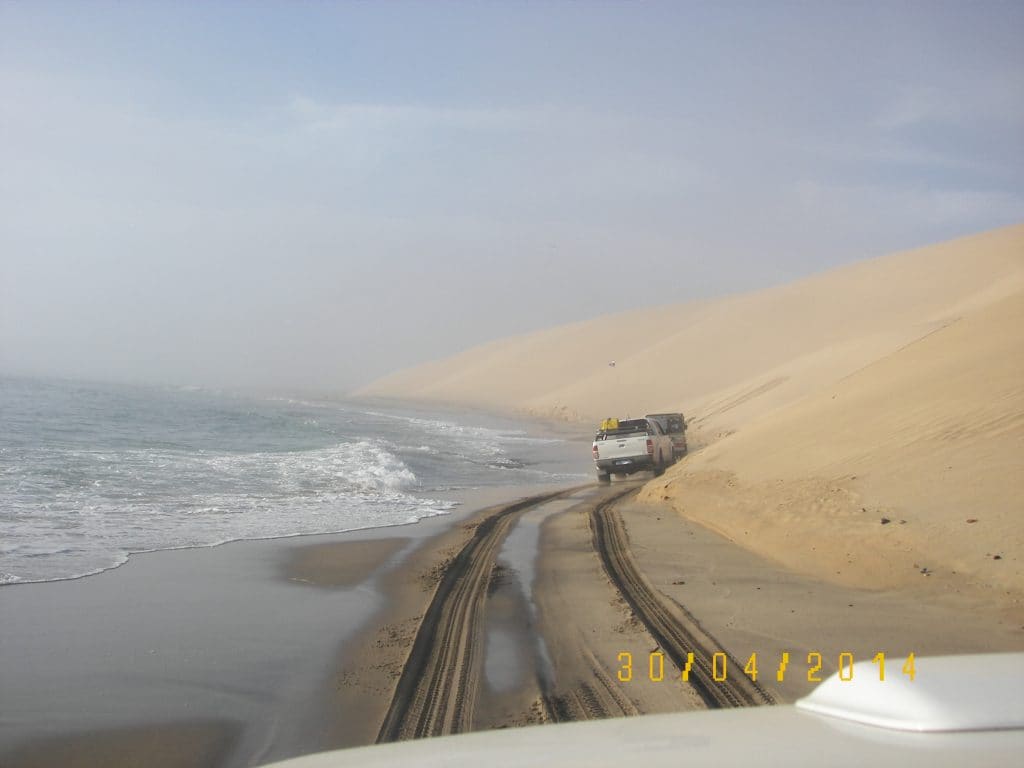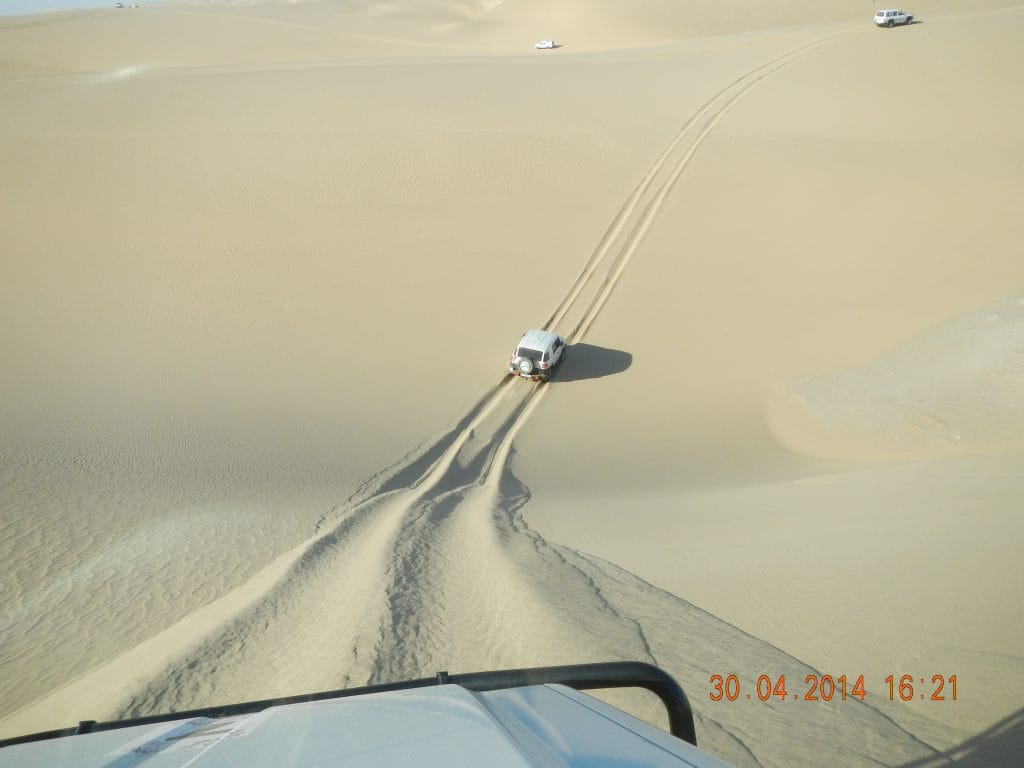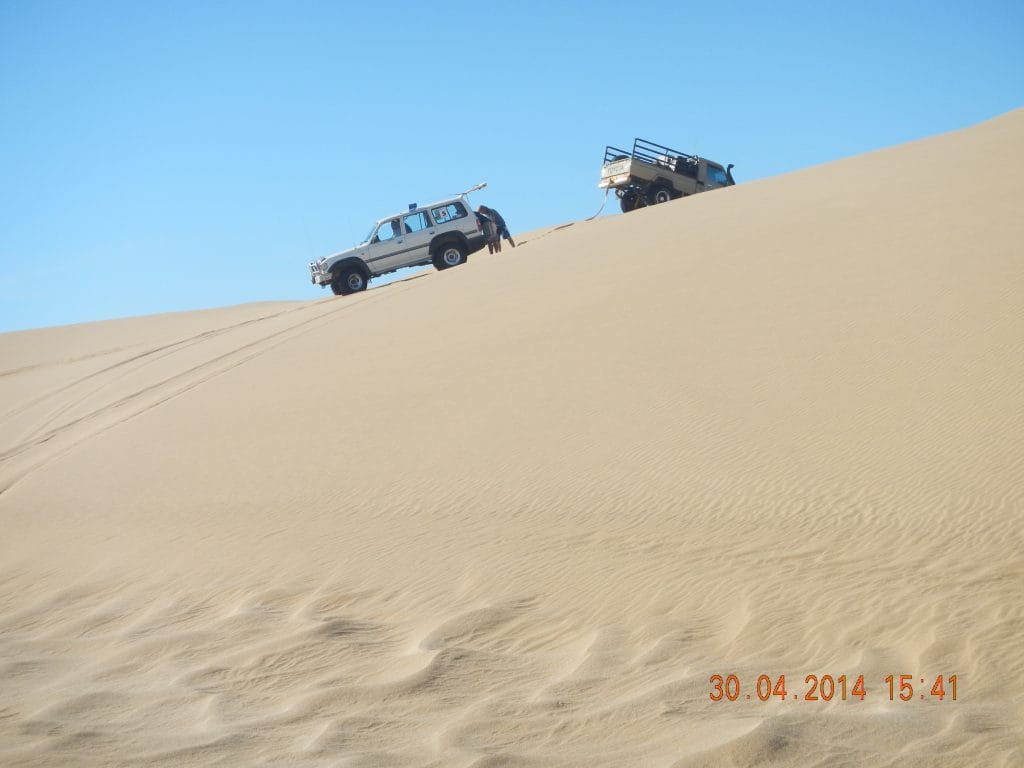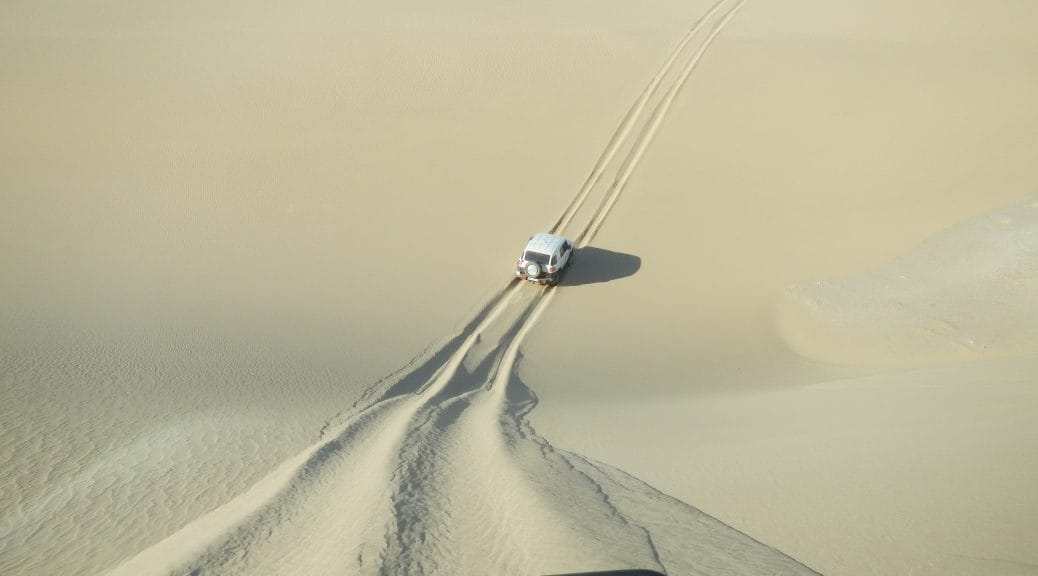Sand is notoriously tough to navigate, posing a challenge to even the most practiced off-roaders. Follow this advice from long-time dune driver Johann Marais for the best chance at success. By Nell Hofmeyr
Dry or wet, loose or compact, sand is a different animal compared to other terrains. It requires patience, skill and developing a sense for the surface.
That said, there are some conventions that ring true every time. To help set you on the path to sand mastery, we reached out to seasoned overlander Johann Marais, a man who has traversed the Namib Desert more times than he can count.
From tyre pressure and dune driving to getting unstuck, here are Johann’s top tips for sand driving:
Before you go
- You need an off-road vehicle to drive on thick sand or dunes.
- Always bring a pressure gauge, tyre inflator and the necessary recovery equipment (see below).
- Make sure your vehicle has recovery points in place.
- Use mud-terrain tyres for better flotation and grip.
- Avoid driving alone. You’ll need help if you get stuck!

Deflate your tyres
The first rule of sand driving is to lower your tyre pressure. This lengthens the tyre’s “footprint” which improves traction, reduces strain on your vehicle and protects the tracks. When a larger surface area touches the sand, the tyres are better able to support the weight of the vehicle. In Johann’s words, it helps you “to be on the sand and not in the sand”.
Fail to deflate your tyres properly and you will get stuck. “The moment the wheels start digging in, you sink away. It’s as simple as that,” he says.
Just don’t go too low or the tyres become vulnerable to damage and run the risk of de-beading.
The optimal pressure depends on your vehicle type, weight and tyre profile. Experiment ahead of time to find what works for you. The more you practise on sand, the better you’ll get at judging the terrain and adjusting the pressure accordingly.
If you don’t know where to start, Johann recommends 0.8 bar on sand as a good rule of thumb.
T4A tip: Check that your pressure gauge is in working order. Even the slightest discrepancy can yield bad results. “In sand, 0.2 or 0.3 of the bar makes a big difference. I recommend using a digital gauge for the most reliable reading,” Johann says.
Also read: How to drive on gravel roads
Sand driving techniques
Move off You need plenty of power so use low-range for moving off and make smooth gear changes. For a smooth start, make sure the wheels are pointing straight ahead.
Speed Drive slowly and keep a steady pace. Conserve your momentum because once lost, it’s not easily regained. You also want to avoid rapid changes in speed as this will merely cause your wheels to dig in.
Steering Avoid abrupt movements and sharp turns. Keep steering to a minimum and let the wheels recentre themselves, giving only small inputs where necessary. It’s advisable to stick to existing tracks as they are firmer and offer better traction.
Braking A big no-no on sand. To stop, press the clutch and let the vehicle coast to a halt. Braking causes sand ridges to build up in front of the wheels, potentially causing you to get bogged down. Before moving off again, reverse about 1 metre. This not only compacts the sand for pulling away but ensures that your vehicle already has some momentum by the time it reaches the ridge where it came to a stop.
Uphill Choose the right gear so you have enough momentum to reach the top without flying over. If you need to gear down, do it quickly. “Many people leave it too late and lose their momentum as a result. If that happens, gearing down won’t help you get it back,” cautions Johann.
T4A tip: Don’t be overzealous with the accelerator when changing gears. Once again, you’ll just get stuck.
Downhill “It’s the same as going down any steep surface – you need to use a low gear so the car cannot run away,” he says. Remember to keep the vehicle straight: “If the backend slips sideways, accelerate slightly to straighten the car.”

Driving on dunes
Step 1: Don’t ever go dune driving by yourself. “If you do it alone, you’re in trouble. That’s the standard principle for any remote area, really. You always go with others.”
Step 2: Size up the dune so you know what you’re working with and formulate a plan of action.
Step 3: Observe what others are doing and ask questions. “Even with years of experience, I ask for help if I need it. If someone tackles an obstacle of any sort and succeeds, I’m the first to ask: ‘What gear did you try that in?’”
Step 4: Keep straight and maintain a steady momentum going up and going down. “Come up too slow and you’ll hang the vehicle on the crest of the dune; but go too fast and you can damage your vehicle extensively.”
Step 5: Can’t make it all the way up? Do not coast back down; rather reverse in gear. Keep your wheels straight and drive back down. The rear wheels will follow the track which you created going up.
Buy now: Namibia & Botswana Self-Drive Guidebooks Combo: Edition 2

Sand recovery
The convention is for every vehicle to have its own recovery equipment. It’s okay to ask for assistance from others in an emergency but don’t rely on their gear – it’s considered poor etiquette.
Johann recommends these items for your recovery kit:
- Snatch strap or rope
- At least 2 high-quality shackles
- Optional: a piece of chain (your plan B for a vehicle with no recovery points)
Recovery tips
- Lower your tyre pressure even further.
- Switch to low range. The vehicle is then much stronger, plus hi-range might damage your clutch.
- Reverse on your own tracks if possible.
- Remove the build-up of sand behind or in front of the tyres.
- In a snatch strap recovery, always maintain a distance that’s roughly twice the length of the recovery strap – about 50-60 metres. Should the strap break, the shackle catapults and quickly transforms into a lethal weapon. Tip: Open the bonnet of the car during recovery to protect the windscreen and the person in the vehicle should the shackle go flying.
- It is not advisable to recover another vehicle in reverse. Rather turn the tow vehicle around and do the recovery moving forward.
- Consider buying plasma ropes for durability.
- Don’t buy unmarked metal shackles as they may not be from a reputable brand.
What’s been your most memorable dune destination? Share your experience in the comments!


10 years in the UAE dune bashing every weekend – there’s no substitute for experience.
Hi, I’m Mike Bosetti from Germany. Have been travelling sand deserts in Algeria, Tunesia, Marocco, Namibia etc.
Just one more tipp for dune drivers:
in case you have a strong engine: when you go uphill, don’t keep the pedal to the metal all the time. You might dig in, before you reach the crest of the dune.
The car will slow down on steep dunes the farther you go up, and you should reduce power accordingly, so that the wheels don’t start digging.
Good luck guys!
BR Mike
“If you don’t know where to start, Johann recommends 0.08 bar on sand as a good rule of thumb”
Really? Apart from the obvious typo, if you “don’t know”, starting at 0.8 is equally as risky (due to debeading) as it is to get stuck. I would rather get stuck than have to change a wheel in soft sand and then have to deal with re-seating the tyre on the rim.
My 2c worth.